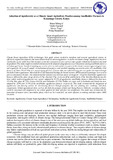| dc.contributor.author | Ndung'u, Simon | |
| dc.contributor.author | Ogemah, Vitalis | |
| dc.contributor.author | Thiga, Moses | |
| dc.contributor.author | Wandahwa, Philip | |
| dc.date.accessioned | 2023-12-07T13:39:12Z | |
| dc.date.available | 2023-12-07T13:39:12Z | |
| dc.date.issued | 2023-11-17 | |
| dc.identifier.uri | https://doi.org/10.51867/ajernet.4.2.118 | |
| dc.identifier.uri | https://ajernet.net/ojs/index.php/ajernet/article/view/207 | |
| dc.identifier.uri | http://ir-library.mmust.ac.ke:8080/xmlui/handle/123456789/2456 | |
| dc.description.abstract | Climate Smart Agriculture (CSA) technologies help guide actions needed to transform and reorient agricultural systems to effectively support development and ensure food security by increasing farmers’ resilience to climate change. Agroforestry has been vouched for as one of the best CSAs because it provides ecosystem services such as water quality enhancement and prevents land degradation. This study sought to establish and document the adoption of agroforestry as a CSA practice among smallholder farmers in Kakamega County. Stratified sampling was used to select six sub-counties to represent the county's various agroecological zones and regions for the research sample. A combination of purposive and snowball sampling was used to select 428 smallholder CSA farmers, of whom 376 (87.9%) were practicing agroforestry. Primary data was collected using interview guides developed through the Kobo Collect application. Microsoft Excel and Statistical Package for Social Sciences (SPSS) statistical packages were used to process and analyze the data. This study found that wood fuel was the main source of energy for 73% of the smallholder agroforestry farmers, followed by solar energy devices (12%), charcoal (7%), electricity (6%), and kerosene (2%). Grevillea Robusta was the most widely preferred agroforestry tree variety, adopted by 91.8% of agroforestry smallholder farmers, followed by fruit trees (73.4%), blue gums (67.3%), Cyprus (34.0%), and Calliandra (37.5%). Fodder tree types such as Sesbania and Casuarina were adopted by 30.9% and 23.9% of the smallholder agroforestry farmers, respectively. This study recommends the integration of agroforestry into farming systems by incentivizing farmers through programs like tree planting, free seedlings, and farm competitions. School agricultural clubs, such as 4K clubs for primary schools and Young Farmers Clubs for secondary schools, could be motivated and supported to use school gardens for food and fruit tree production. This study also recommends the promotion of modern stoves (maendeleo jikos), which use less wood fuel, are more efficient in cooking, and also reduce GHG emissions. | en_US |
| dc.language.iso | en | en_US |
| dc.publisher | AFRICAN JOURNAL OF EMPIRICAL RESEARCH | en_US |
| dc.subject | Adoption, Agroforestry,Climate, Smart, Agriculture, Practice, Smallholder, Farmers, County, | en_US |
| dc.title | Adoption of Agroforestry as a Climate Smart Agriculture Practice among Smallholder Farmers in Kakamega County, Kenya | en_US |
| dc.type | Article | en_US |

